Quantification of Gas Flaring from Satellite Imagery: A Comparison of Two Methods for SLSTR and BIROS Imagery
Abstract
:1. Introduction
2. Materials and Methods
2.1. Satellite Products
2.2. Study Area
2.3. Calibration-Based Method
2.4. Physico-Chemical-Based Method
3. Results
3.1. Detections and Flaring Activity with SLSTR
3.2. Flaring Activity with BIROS
3.3. Comparison of Flaring Activity
3.3.1. Bulk Comparison in Time and Space
3.3.2. Bulk Comparison in Time, Detailed in Space
3.3.3. Near-Coincidental Activity
4. Discussion
5. Conclusions
Author Contributions
Funding
Institutional Review Board Statement
Informed Consent Statement
Data Availability Statement
Conflicts of Interest
References
- Ghadyanlou, F.; Vatani, A. Flare-gas recovery methods for olefin plants. Chem. Eng. 2015, 122, 66. [Google Scholar]
- Myachina, K.; Petrishchev, V.; Chibilev, A.; Krasnov, E. The Features of the Formation and the Functioning Principles of Oil and Gas Field Technogeosystems. Geogr. Nat. Resour. 2021, 42, 10–16. [Google Scholar] [CrossRef]
- Morakinyo, B.; Lavender, S.; Abbott, V. Retrieval of Land Surface Temperature from Earth Observation Satellites for Gas Flaring Sites in the Niger Delta, Nigeria. Int. J. Environ. Monit. Anal. 2020, 8, 59. [Google Scholar] [CrossRef]
- Morakinyo, B.O.; Lavender, S.; Abbott, V. Detection of potentially gas flaring related pollution on vegetation cover and its health using remotely sensed data in the Niger delta, Nigeria. Asian Rev. Environ. Earth Sci. 2023, 10, 1–13. [Google Scholar]
- Anejionu, O.C.D.; Duncan Whyatt, J.; Alan Blackburn, G.; Price, C.S. Contributions of gas flaring to a global air pollution hotspot: Spatial and temporal variations, impacts and alleviation. Atmos. Environ. 2015, 118, 184–193. [Google Scholar] [CrossRef] [Green Version]
- Johnston, J.E.; Chau, K.; Franklin, M.; Cushing, L. Environmental Justice Dimensions of Oil and Gas Flaring in South Texas: Disproportionate Exposure among Hispanic communities. Environ. Sci. Technol. 2020, 54, 6289–6298. [Google Scholar] [CrossRef]
- Willis, M.; Hystad, P.; Denham, A.; Hill, E. Natural gas development, flaring practices and paediatric asthma hospitalizations in Texas. Int. J. Epidemiol. 2020, 49, 1883–1896. [Google Scholar] [CrossRef]
- Chen, C.; McCabe, D.C.; Fleischman, L.E.; Cohan, D.S. Black Carbon Emissions and Associated Health Impacts of Gas Flaring in the United States. Atmosphere 2022, 13, 385. [Google Scholar] [CrossRef]
- Olivier, J.G. Trends in Global CO2 and Total Greenhouse Gas Emissions: 2021 Report; Technical Report 4758; PBL Netherlands Environmental Assessment Agency: Amsterdam, The Netherlands, 2022. [Google Scholar]
- Burtt, D.C.; Corbin, D.J.; Armitage, J.R.; Crosland, B.M.; Jefferson, A.M.; Kopp, G.A.; Kostiuk, L.W.; Johnson, M.R. A methodology for quantifying combustion efficiencies and species emission rates of flares subjected to crosswind. J. Energy Inst. 2022, 104, 124–132. [Google Scholar] [CrossRef]
- Nwosisi, M.; Oguntoke, O.; Taiwo, A. Dispersion and emission patterns of NO2 from gas flaring stations in the Niger Delta, Nigeria. Model. Earth Syst. Environ. 2020, 6, 73–84. [Google Scholar] [CrossRef]
- Brocchi, V.; Krysztofiak, G.; Deroubaix, A.; Stratmann, G.; Sauer, D.; Schlager, H.; Deetz, K.; Dayma, G.; Robert, C.; Chevrier, S.; et al. Local air pollution from oil rig emissions observed during the airborne DACCIWA campaign. Atmos. Chem. Phys. 2019, 19, 11401–11411. [Google Scholar] [CrossRef] [Green Version]
- Shaw, J.T.; Foulds, A.; Wilde, S.; Barker, P.; Squires, F.A.; Lee, J.; Purvis, R.; Burton, R.; Colfescu, I.; Mobbs, S.; et al. Flaring efficiencies and NOx emission ratios measured for offshore oil and gas facilities in the North Sea. Atmos. Chem. Phys. 2023, 23, 1491–1509. [Google Scholar] [CrossRef]
- Yuan, B.; Kaser, L.; Karl, T.; Graus, M.; Peischl, J.; Campos, T.L.; Shertz, S.; Apel, E.C.; Hornbrook, R.S.; Hills, A.; et al. Airborne flux measurements of methane and volatile organic compounds over the Haynesville and Marcellus shale gas production regions. J. Geophys. Res. Atmos. 2015, 120, 6271–6289. [Google Scholar] [CrossRef] [Green Version]
- Halliday, H.S.; Thompson, A.M.; Wisthaler, A.; Blake, D.R.; Hornbrook, R.S.; Mikoviny, T.; Müller, M.; Eichler, P.; Apel, E.C.; Hills, A.J. Atmospheric benzene observations from oil and gas production in the Denver-Julesburg Basin in July and August 2014. J. Geophys. Res. Atmos. 2016, 121, 11055–11074. [Google Scholar] [CrossRef] [Green Version]
- Gvakharia, A.; Kort, E.A.; Brandt, A.; Peischl, J.; Ryerson, T.B.; Schwarz, J.P.; Smith, M.L.; Sweeney, C. Methane, Black Carbon, and Ethane Emissions from Natural Gas Flares in the Bakken Shale, North Dakota. Environ. Sci. Technol. 2017, 51, 5317–5325. [Google Scholar] [CrossRef]
- Fawole, O.G.; Cai, X.; MacKenzie, A.R. Evidence for a gas-flaring source of alkanes leading to elevated ozone in air above West Africa. Afr. J. Environ. Sci. Technol. 2017, 11, 532–543. [Google Scholar] [CrossRef]
- McEwen, J.D.; Johnson, M.R. Black carbon particulate matter emission factors for buoyancy-driven associated gas flares. J. Air Waste Manag. Assoc. 2012, 62, 307–321. [Google Scholar] [CrossRef] [Green Version]
- Stohl, A.; Klimont, Z.; Eckhardt, S.; Kupiainen, K.; Shevchenko, V.P.; Kopeikin, V.M.; Novigatsky, A.N. Black carbon in the Arctic: The underestimated role of gas flaring and residential combustion emissions. Atmos. Chem. Phys. 2013, 13, 8833–8855. [Google Scholar] [CrossRef] [Green Version]
- Huang, K.; Fu, J.S. A global gas flaring black carbon emission rate dataset from 1994 to 2012. Sci. Data 2016, 3, 160104. [Google Scholar] [CrossRef] [Green Version]
- Fawole, O.G.; MacKenzie, A.R.; Cai, X. Gas flaring and resultant air pollution: A review focusing on black carbon. Environ. Pollut. 2016, 216, 182–197. [Google Scholar]
- Böttcher, K.; Paunu, V.V.; Kupiainen, K.; Zhizhin, M.; Matveev, A.; Savolahti, M.; Klimont, Z.; Väätäinen, S.; Lamberg, H.; Karvosenoja, N. Black carbon emissions from flaring in Russia in the period 2012–2017. Atmos. Environ. 2021, 254, 118390. [Google Scholar] [CrossRef]
- Winiger, P.; Barrett, T.E.; Sheesley, R.J.; Huang, L.; Sharma, S.; Barrie, L.A.; Yttri, K.E.; Evangeliou, N.; Eckhardt, S.; Stohl, A.; et al. Source apportionment of circum-Arctic atmospheric black carbon from isotopes and modeling. Sci. Adv. 2019, 5, eaau8052. [Google Scholar] [CrossRef] [PubMed] [Green Version]
- Klimont, Z.; Kupiainen, K.; Heyes, C.; Purohit, P.; Cofala, J.; Rafaj, P.; Borken Kleefeld, J.; Schöpp, W. Global anthropogenic emissions of particulate matter including black carbon. Atmos. Chem. Phys. 2017, 17, 8681–8723. [Google Scholar] [CrossRef] [Green Version]
- Caseiro, A.; Gehrke, B.; Rücker, G.; Leimbach, D.; Kaiser, J.W. Gas flaring activity and black carbon emissions in 2017 derived from the Sentinel-3A Sea and Land Surface Temperature Radiometer. Earth Syst. Sci. Data 2020, 12, 2137–2155. [Google Scholar] [CrossRef]
- Fawole, O.G.; Cai, X.; Levine, J.G.; Pinker, R.T.; MacKenzie, A.R. Detection of a gas flaring signature in the AERONET optical properties of aerosols at a tropical station in West Africa. J. Geophys. Res. Atmos. 2016, 121, 14513–14524. [Google Scholar] [CrossRef]
- Fawole, O.G.; Cai, X.; Pinker, R.T.; MacKenzie, A.R. Analysis of Radiative Properties and Direct Radiative Forcing Estimates of Dominant Aerosol Clusters over an Urban-Desert Region in West Africa. Aerosol Air Qual. Res. 2019, 19, 38–48. [Google Scholar] [CrossRef]
- Schacht, J.; Heinold, B.; Quaas, J.; Backman, J.; Cherian, R.; Ehrlich, A.; Herber, A.; Huang, W.T.K.; Kondo, Y.; Massling, A.; et al. The importance of the representation of air pollution emissions for the modeled distribution and radiative effects of black carbon in the Arctic. Atmos. Chem. Phys. 2019, 19, 11159–11183. [Google Scholar] [CrossRef] [Green Version]
- Qi, L.; Wang, S. Sources of black carbon in the atmosphere and in snow in the Arctic. Sci. Total Environ. 2019, 691, 442–454. [Google Scholar] [CrossRef]
- Cho, M.H.; Park, R.J.; Yoon, J.; Choi, Y.; Jeong, J.I.; Labzovskii, L.; Fu, J.S.; Huang, K.; Jeong, S.J.; Kim, B.M. A missing component of Arctic warming: Black carbon from gas flaring. Environ. Res. Lett. 2019, 14, 094011. [Google Scholar] [CrossRef] [Green Version]
- Zhu, C.; Kanaya, Y.; Takigawa, M.; Ikeda, K.; Tanimoto, H.; Taketani, F.; Miyakawa, T.; Kobayashi, H.; Pisso, I. FLEXPART v10.1 simulation of source contributions to Arctic black carbon. Atmos. Chem. Phys. 2020, 20, 1641–1656. [Google Scholar] [CrossRef] [Green Version]
- Ialongo, I.; Stepanova, N.; Hakkarainen, J.; Virta, H.; Gritsenko, D. Satellite-based estimates of nitrogen oxide and methane emissions from gas flaring and oil production activities in Sakha Republic, Russia. Atmos. Environ. X 2021, 11, 100114. [Google Scholar] [CrossRef]
- Caulton, D.R.; Shepson, P.B.; Cambaliza, M.O.L.; McCabe, D.; Baum, E.; Stirm, B.H. Methane Destruction Efficiency of Natural Gas Flares Associated with Shale Formation Wells. Environ. Sci. Technol. 2014, 48, 9548–9554. [Google Scholar] [CrossRef] [PubMed]
- Plant, G.; Kort, E.A.; Brandt, A.R.; Chen, Y.; Fordice, G.; Negron, A.M.G.; Schwietzke, S.; Smith, M.; Zavala-Araiza, D. Inefficient and unlit natural gas flares both emit large quantities of methane. Science 2022, 377, 1566–1571. [Google Scholar] [CrossRef] [PubMed]
- Faruolo, M.; Caseiro, A.; Lacava, T.; Kaiser, J.W. Gas Flaring: A Review Focused On Its Analysis From Space. IEEE Geosci. Remote Sens. Mag. 2021, 9, 258–281. [Google Scholar] [CrossRef]
- Nwozor, A.; Olanrewaju, J.S.; Ake, M.; Aleyomi, M. Global Quest for Zero Routine Flaring: An Appraisal of Nigeria’s Legal and Regulatory Abatement Frameworks. Electron. Green J. 2020, 1, 1–16. [Google Scholar] [CrossRef]
- CCAP. Global Methane Pledge. 2023. Available online: https://www.globalmethanepledge.org/ (accessed on 20 June 2023).
- Elvidge, C.D.; Zhizhin, M.; Baugh, K.; Hsu, F.C.; Ghosh, T. Methods for Global Survey of Natural Gas Flaring from Visible Infrared Imaging Radiometer Suite Data. Energies 2016, 9, 14. [Google Scholar] [CrossRef] [Green Version]
- Duren, R.; Gordon, D. Tackling unlit and inefficient gas flaring. Science 2022, 377, 1486–1487. [Google Scholar] [CrossRef]
- Liu, Y.; Pu, Y.; Hu, X.; Dong, Y.; Wu, W.; Hu, C.; Zhang, Y.; Wang, S. Global declines of offshore gas flaring inadequate to meet the 2030 goal. Nat. Sustain. 2023. [Google Scholar] [CrossRef]
- Do, Q.T.; Shapiro, J.N.; Elvidge, C.D.; Abdel-Jelil, M.; Ahn, D.P.; Baugh, K.; Hansen-Lewis, J.; Zhizhin, M.; Bazilian, M.D. Terrorism, geopolitics, and oil security: Using remote sensing to estimate oil production of the Islamic State. Energy Res. Soc. Sci. 2018, 44, 411–418. [Google Scholar] [CrossRef]
- Korppoo, A. Russian associated petroleum gas flaring limits: Interplay of formal and informal institutions. Energy Policy 2018, 116, 232–241. [Google Scholar] [CrossRef]
- Zhang, Y.; Gautam, R.; Zavala-Araiza, D.; Jacob, D.J.; Zhang, R.; Zhu, L.; Sheng, J.X.; Scarpelli, T. Satellite-Observed Changes in Mexico’s Offshore Gas Flaring Activity Linked to Oil/Gas Regulations. Geophys. Res. Lett. 2019, 46, 1879–1888. [Google Scholar] [CrossRef] [Green Version]
- Asadov, I.H. Optimum choice of regime indicators of associated petroleum gas burning for minimizing the degree of aerosolic air pollution in oil and gas production areas. Oil Gas Bus. 2020, 3, 18. [Google Scholar] [CrossRef]
- Al-Zuwayer, H.R.; Singhal, V.; Al-Sughayer, N.Y. KOC Flaring Success Story. In Proceedings of the SPE Kuwait Oil and Gas Show and Conference, Mishref, Kuwait, 5 October 2015. [Google Scholar] [CrossRef]
- Lu, R.; Miskimins, J.L.; Zhizhin, M. Learning from Nighttime Observations of Gas Flaring in North Dakota for Better Decision and Policy Making. Remote Sens. 2021, 13, 941. [Google Scholar] [CrossRef]
- Facchinelli, F.; Pappalardo, S.E.; Codato, D.; Diantini, A.; Della Fera, G.; Crescini, E.; De Marchi, M. Unburnable and Unleakable Carbon in Western Amazon: Using VIIRS Nightfire Data to Map Gas Flaring and Policy Compliance in the Yasuní Biosphere Reserve. Sustainability 2019, 12, 58. [Google Scholar] [CrossRef] [Green Version]
- Elvidge, C.; Baugh, K.; Hobson, V.; Kihn, E.; Kroehl, H.; Davis, E.; Cocero, D. Satellite inventory of human settlements using nocturnal radiation emissions: A contribution for the global toolchest. Glob. Chang. Biol. 1997, 3, 387–395. [Google Scholar] [CrossRef]
- Elvidge, C.D.; Imhoff, M.L.; Baugh, K.E.; Hobson, V.R.; Nelson, I.; Safran, J.; Dietz, J.B.; Tuttle, B.T. Night-time lights of the world: 1994‚ Äì1995. ISPRS J. Photogramm. Remote Sens. 2001, 56, 81–99. [Google Scholar] [CrossRef]
- Elvidge, C.D.; Baugh, K.E.; Tuttle, B.T.; Howard, A.T.; Pack, D.W.; Milesi, C.; Erwin, E.H. A Twelve Year Record of National and Global Gas Flaring Volumes Estimated Using Satellite Data; Technical Report; World Bank: Washington, DC, USA, 2007. [Google Scholar]
- Elvidge, C.D.; Ziskin, D.; Baugh, K.E.; Tuttle, B.T.; Ghosh, T.; Pack, D.W.; Erwin, E.H.; Zhizhin, M. A Fifteen Year Record of Global Natural Gas Flaring Derived from Satellite Data. Energies 2009, 2, 595–622. [Google Scholar] [CrossRef] [Green Version]
- Elvidge, C.D.; Baugh, K.; Tuttle, B.; Ziskin, D.; Ghosh, T.; Zhizhin, M.; Pack, D. Improving Satellite Data Estimation of Gas Flaring Volumes; Technical Report; GGFR-World Bank: Washington, DC, USA, 2009. [Google Scholar]
- Elvidge, C.D.; Baugh, K.; Ghosh, T.; Zhizhin, M.; Hsu, F.C.; Sparks, T.; Bazilian, M.; Sutton, P.C.; Houngbedji, K.; Goldblatt, R. Fifty years of nightly global low-light imaging satellite observations. Front. Remote Sens. 2022, 3, 919937. [Google Scholar] [CrossRef]
- Croft, T. Burning waste gas in oil fields. Nature 1973, 245, 375–376. [Google Scholar] [CrossRef]
- Matson, M.; Dozier, J. Identification of subresolution high temperature sources using a thermal IR sensor. Photogramm. Eng. Remote Sens. 1981, 47, 1311–1318. [Google Scholar]
- Muirhead, K.; Cracknell, A.P. Identification of gas flares in the North Sea using satellite data. Int. J. Remote Sens. 1984, 5, 199–212. [Google Scholar] [CrossRef]
- Elvidge, C.D.; Baugh, K.E.; Ziskin, D.; Anderson, S.; Ghosh, T. Estimation of Gas Flaring Volumes Using NASA MODIS Fire Detection Products; Technical Report; NOAA National Geophysical Data Center: Washington, DC, USA, 2011. [Google Scholar]
- Casadio, S.; Arino, O.; Serpe, D. Gas flaring monitoring from space using the {ATSR} instrument series. Remote Sens. Environ. 2012, 116, 239–249. [Google Scholar] [CrossRef]
- Casadio, S.; Arino, O.; Minchella, A. Use of ATSR and SAR measurements for the monitoring and characterisation of night-time gas flaring from off-shore platforms: The North Sea test case. Remote Sens. Environ. 2012, 123, 175–186. [Google Scholar] [CrossRef]
- Elvidge, C.D.; Zhizhin, M.; Hsu, F.C.; Baugh, K.E. VIIRS Nightfire: Satellite Pyrometry at Night. Remote Sens. 2013, 5, 4423–4449. [Google Scholar] [CrossRef] [Green Version]
- Faruolo, M.; Coviello, I.; Filizzola, C.; Lacava, T.; Pergola, N.; Tramutoli, V. A satellite-based analysis of the Val d’Agri Oil Center (southern Italy) gas flaring emissions. Nat. Hazards Earth Syst. Sci. 2014, 14, 2783–2793. [Google Scholar] [CrossRef] [Green Version]
- Anejionu, O.C.D.; Blackburn, G.A.; Whyatt, J.D. Satellite survey of gas flares: Development and application of a Landsat-based technique in the Niger Delta. Int. J. Remote Sens. 2014, 35, 1900–1925. [Google Scholar] [CrossRef] [Green Version]
- Anejionu, O.C.; Blackburn, G.A.; Whyatt, J.D. Detecting gas flares and estimating flaring volumes at individual flow stations using {MODIS} data. Remote Sens. Environ. 2015, 158, 81–94. [Google Scholar] [CrossRef] [Green Version]
- Caseiro, A.; Rücker, G.; Tiemann, J.; Leimbach, D.; Lorenz, E.; Frauenberger, O.; Kaiser, J.W. Persistent Hot Spot Detection and Characterisation Using SLSTR. Remote Sens. 2018, 10, 1118. [Google Scholar] [CrossRef] [Green Version]
- Faruolo, M.; Lacava, T.; Pergola, N.; Tramutoli, V. The VIIRS-Based RST-FLARE Configuration: The Val d’Agri Oil Center Gas Flaring Investigation in Between 2015–2019. Remote Sens. 2020, 12, 819. [Google Scholar] [CrossRef] [Green Version]
- Kato, S.; Miyamoto, H.; Amici, S.; Oda, A.; Matsushita, H.; Nakamura, R. Automated classification of heat sources detected using SWIR remote sensing. Int. J. Appl. Earth Obs. Geoinf. 2021, 103, 102491. [Google Scholar] [CrossRef]
- Elvidge, C.D.; Zhizhin, M.; Hsu, F.C.; Sparks, T.; Ghosh, T. Subpixel Analysis of Primary and Secondary Infrared Emitters with Nighttime VIIRS Data. Fire 2021, 4, 83. [Google Scholar] [CrossRef]
- Faruolo, M.; Falconieri, A.; Genzano, N.; Lacava, T.; Marchese, F.; Pergola, N. A Daytime Multisensor Satellite System for Global Gas Flaring Monitoring. IEEE Trans. Geosci. Remote Sens. 2022, 60, 1–17. [Google Scholar] [CrossRef]
- Wu, W.; Liu, Y.; Rogers, B.M.; Xu, W.; Dong, Y.; Lu, W. Monitoring gas flaring in Texas using time-series sentinel-2 MSI and landsat-8 OLI images. Int. J. Appl. Earth Obs. Geoinf. 2022, 114, 103075. [Google Scholar] [CrossRef]
- Asadi-Fard, E.; Falahatkar, S.; Tanha Ziyarati, M.; Zhang, X.; Faruolo, M. Assessment of RXD Algorithm Capability for Gas Flaring Detection through OLI-SWIR Channels. Sustainability 2023, 15, 5333. [Google Scholar] [CrossRef]
- Anejionu, O.C.D. Rationale, historical developments and advances in remote sensing of gas flares. Int. J. Remote Sens. 2019, 40, 6700–6719. [Google Scholar] [CrossRef]
- Sharma, A.; Wang, J.; Lennartson, E.M. Intercomparison of MODIS and VIIRS Fire Products in Khanty-Mansiysk Russia: Implications for Characterizing Gas Flaring from Space. Atmosphere 2017, 8, 95. [Google Scholar] [CrossRef] [Green Version]
- Zhang, X.; Scheving, B.; Shoghli, B.; Zygarlicke, C.; Wocken, C. Quantifying Gas Flaring CH4 Consumption Using VIIRS. Remote Sens. 2015, 7, 9529. [Google Scholar] [CrossRef] [Green Version]
- Soszyńska, A. FireBIRD Mission Data for Gas Flaring Analysis. In Image and Video Technology; Satoh, S., Ed.; Springer: Cham, Switzerland, 2018; pp. 369–381. [Google Scholar]
- Soszynska, A.K. Parametrisation of Gas Flares Using FireBIRD Infrared Satellite Imagery. Ph.D. Thesis, Humboldt-Universität zu Berlin, Mathematisch-Naturwissenschaftliche Fakultät, Berlin, Germany, 2021. [Google Scholar] [CrossRef]
- Brandt, A.R. Accuracy of satellite-derived estimates of flaring volume for offshore oil and gas operations in nine countries. Environ. Res. Commun. 2020, 2, 051006. [Google Scholar] [CrossRef]
- Schade, G.W. Standardized Reporting Needed to Improve Accuracy of Flaring Data. Energies 2021, 14, 6575. [Google Scholar] [CrossRef]
- Zhang, Z.; Sherwin, E.D.; Brandt, A.R. Estimating global oilfield-specific flaring with uncertainty using a detailed geographic database of oil and gas fields. Environ. Res. Lett. 2021, 16, 124039. [Google Scholar] [CrossRef]
- Johnson, M.R.; Devillers, R.W.; Thomson, K.A. A Generalized Sky-LOSA Method to Quantify Soot/Black Carbon Emission Rates in Atmospheric Plumes of Gas Flares. Aerosol Sci. Technol. 2013, 47, 1017–1029. [Google Scholar] [CrossRef] [Green Version]
- Lawal, M.S.; Fairweather, M.; Gogolek, P.; Ingham, D.B.; Ma, L.; Pourkashanian, M.; Williams, A. CFD predictions of wake-stabilised jet flames in a cross-flow. Energy 2013, 53, 259–269. [Google Scholar] [CrossRef]
- Allen, D.T.; Smith, D.; Torres, V.M.; Saldaña, F.C. Carbon dioxide, methane and black carbon emissions from upstream oil and gas flaring in the United States. Curr. Opin. Chem. Eng. 2016, 13, 119–123. [Google Scholar] [CrossRef]
- Fawole, O.; Cai, X.M.; Nikolova, I.; MacKenzie, A. Self-consistent estimates of emission factors of carboncontaining pollutants from a typical gas flare. Ife J. Sci. 2020, 22, 135–149. [Google Scholar] [CrossRef]
- Morakinyo, B.; Lavender, S.; Abbott, V. Investigation of Potential Prevailing Wind Impact on Land Surface Temperature at Gas Flaring Sites in the Niger Delta, Nigeria. Int. J. Environ. Geoinform. 2022, 9, 179–190. [Google Scholar] [CrossRef]
- Zhang, Y.; Gautam, R.; Pandey, S.; Omara, M.; Maasakkers, J.D.; Sadavarte, P.; Lyon, D.; Nesser, H.; Sulprizio, M.P.; Varon, D.J.; et al. Quantifying methane emissions from the largest oil-producing basin in the United States from space. Sci. Adv. 2020, 6, eaaz5120. [Google Scholar] [CrossRef] [Green Version]
- Chakraborty, S.; Oda, T.; Kalb, V.L.; Wang, Z.; Román, M.O. Potentially underestimated gas flaring activities—A new approach to detect combustion using machine learning and NASA’s Black Marble product suite. Environ. Res. Lett. 2023, 18, 035001. [Google Scholar] [CrossRef]
- Lu, W.; Liu, Y.; Wang, J.; Xu, W.; Wu, W.; Liu, Y.; Zhao, B.; Li, H.; Li, P. Global proliferation of offshore gas flaring areas. J. Maps 2020, 16, 396–404. [Google Scholar] [CrossRef]
- Fischer, C.; Halle, W.; Säuberlich, T.; Frauenberger, O.; Hartmann, M.; Oertel, D.; Terzibaschian, T. Small Satellite Tools for High-Resolution Infrared Fire Monitoring. J. Imaging 2022, 8, 49. [Google Scholar] [CrossRef]
- Johnson, M.R.; Tyner, D.R.; Conrad, B.M. Origins of Oil and Gas Sector Methane Emissions: On-Site Investigations of Aerial Measured Sources. Environ. Sci. Technol. 2023, 57, 2484–2494. [Google Scholar] [CrossRef]
- Pohl, J.H.; Tichenor, B.A.; Lee, J.; Payne, R. Combustion Efficiency of Flares. Combust. Sci. Technol. 1986, 50, 217–231. [Google Scholar] [CrossRef]
- Elvidge, C.D.; Bazilian, M.D.; Zhizhin, M.; Ghosh, T.; Baugh, K.; Hsu, F.C. The potential role of natural gas flaring in meeting greenhouse gas mitigation targets. Energy Strategy Rev. 2018, 20, 156–162. [Google Scholar] [CrossRef]
- Faruolo, M.; Genzano, N.; Marchese, F.; Pergola, N. A Tailored Approach for the Global Gas Flaring Investigation by Means of Daytime Satellite Imagery. Remote Sens. 2022, 14, 6319. [Google Scholar] [CrossRef]
- Faruolo, M.; Genzano, N.; Marchese, F.; Pergola, N. Multi-Temporal Satellite Investigation of gas Flaring in Iraq and Iran: The DAFI Porting on Collection 2 Landsat 8/9 and Sentinel 2A/B. Sensors 2023, 23, 5734. [Google Scholar] [CrossRef]


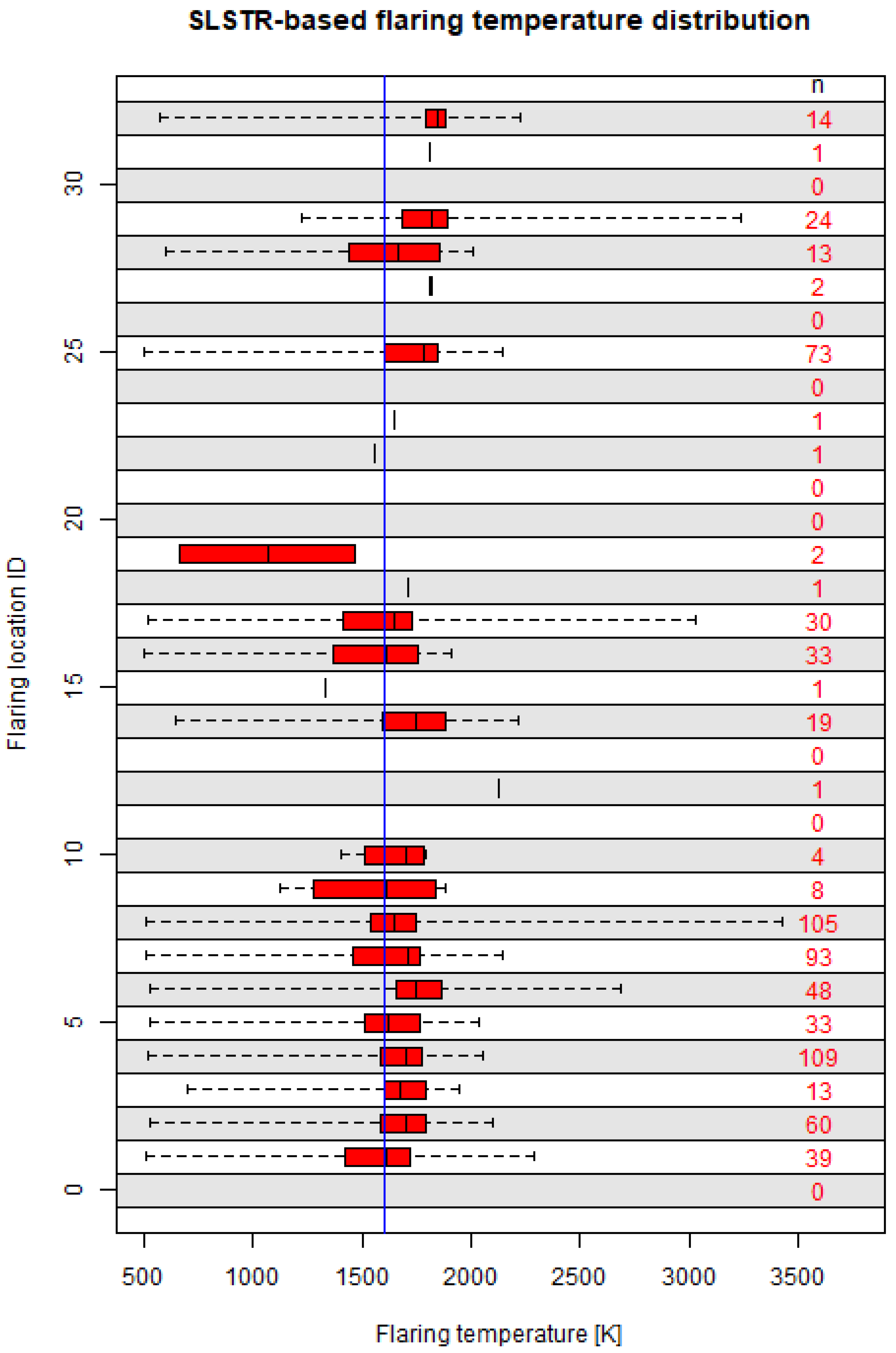
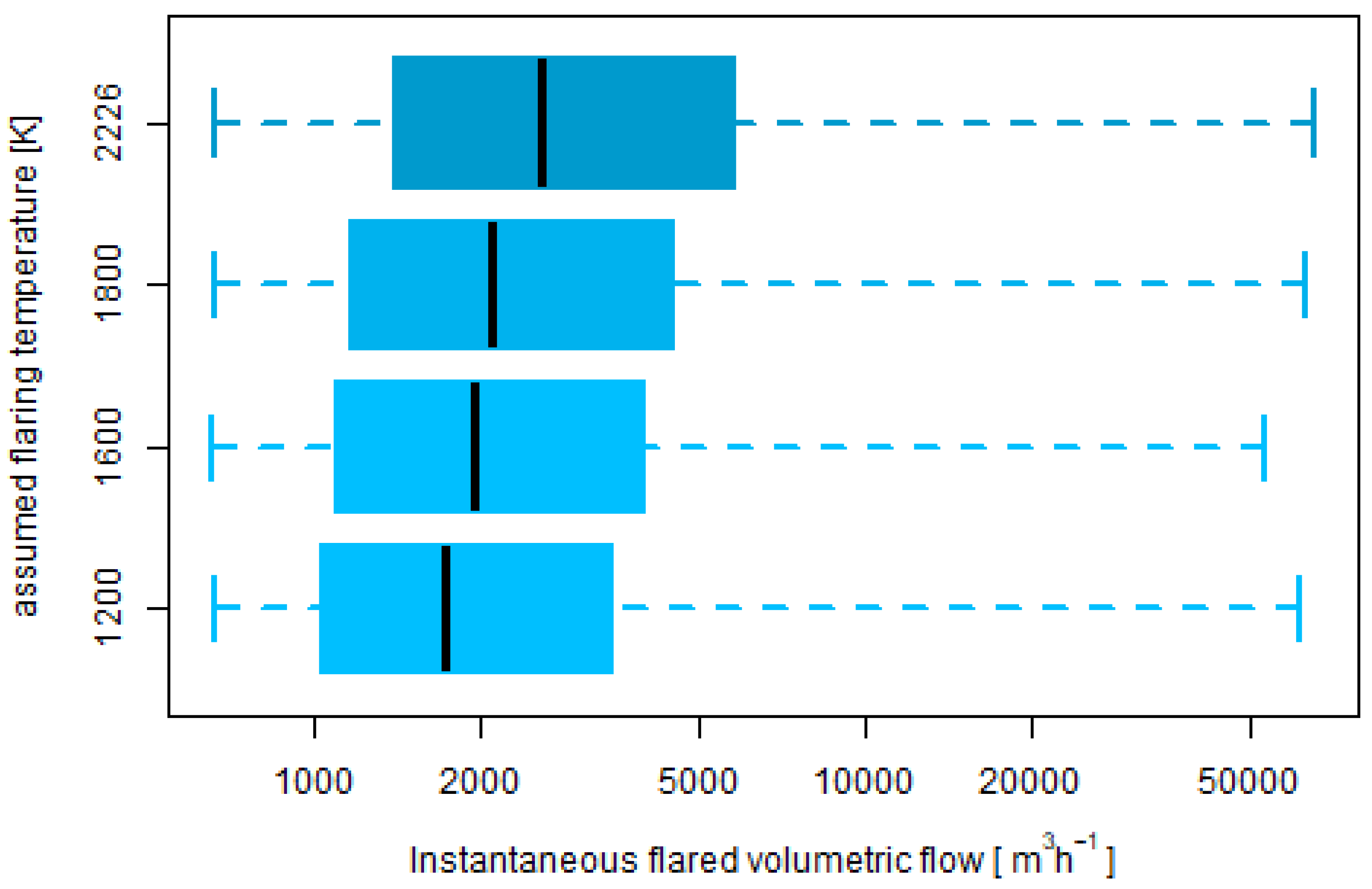

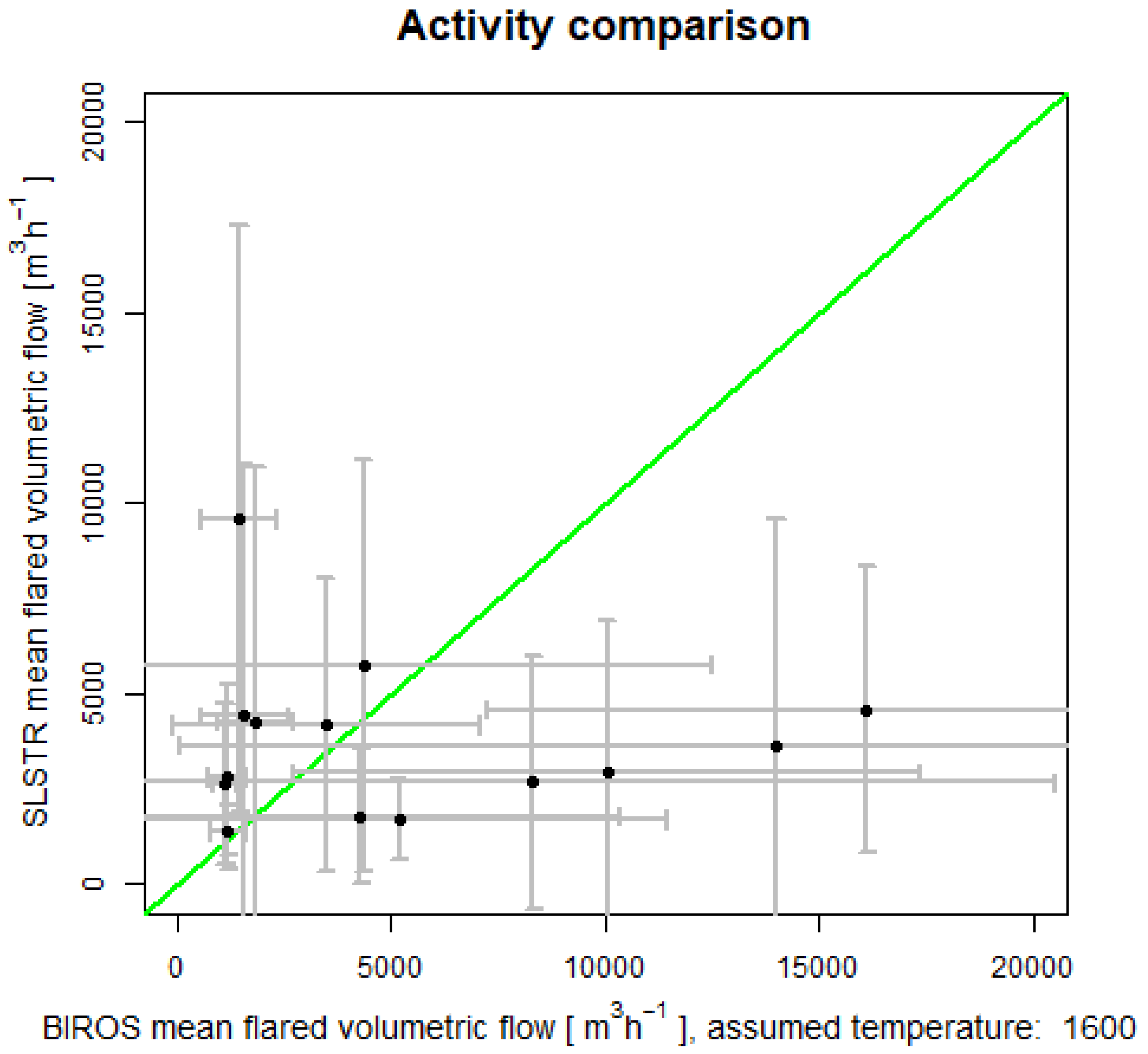
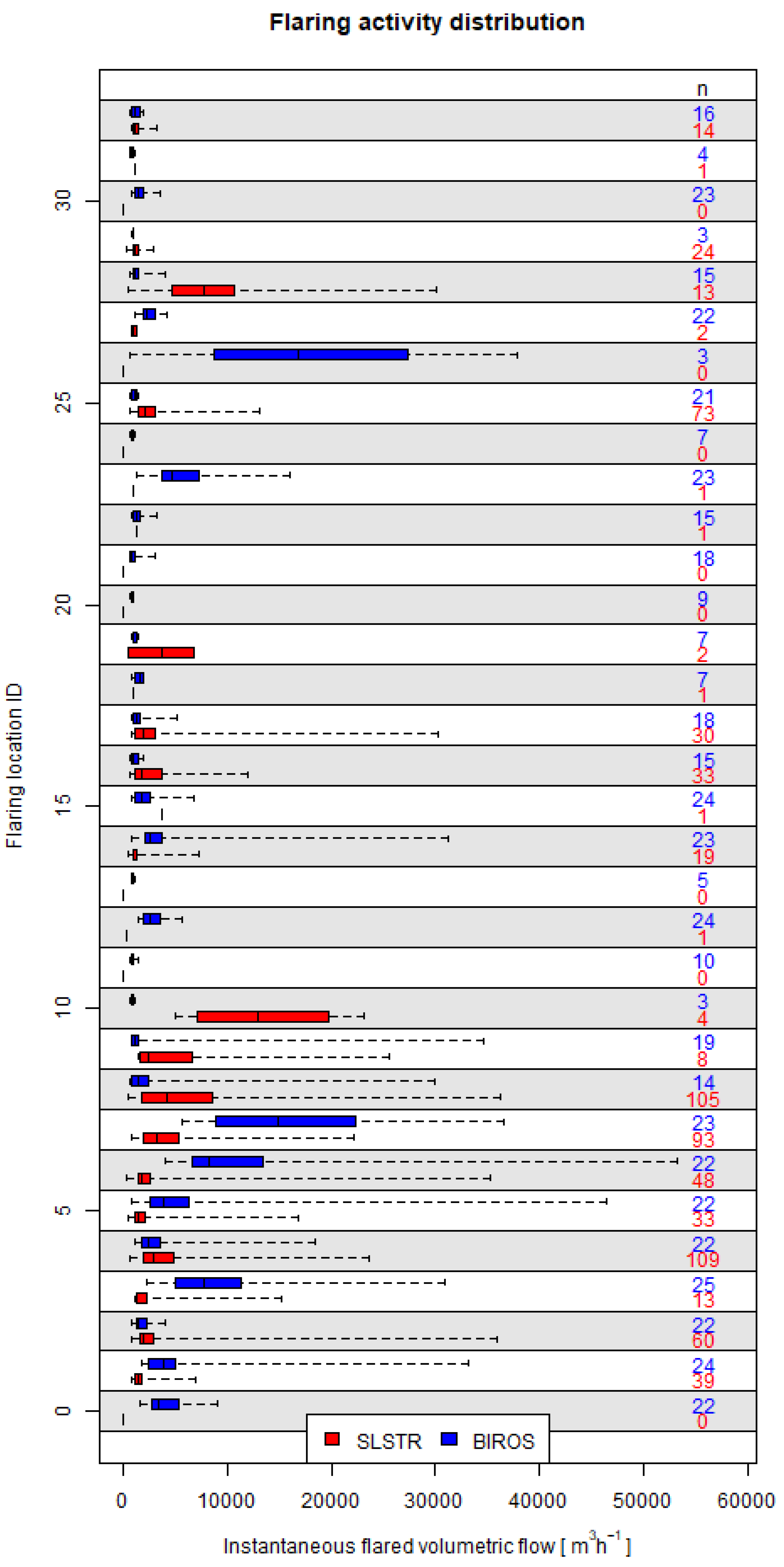
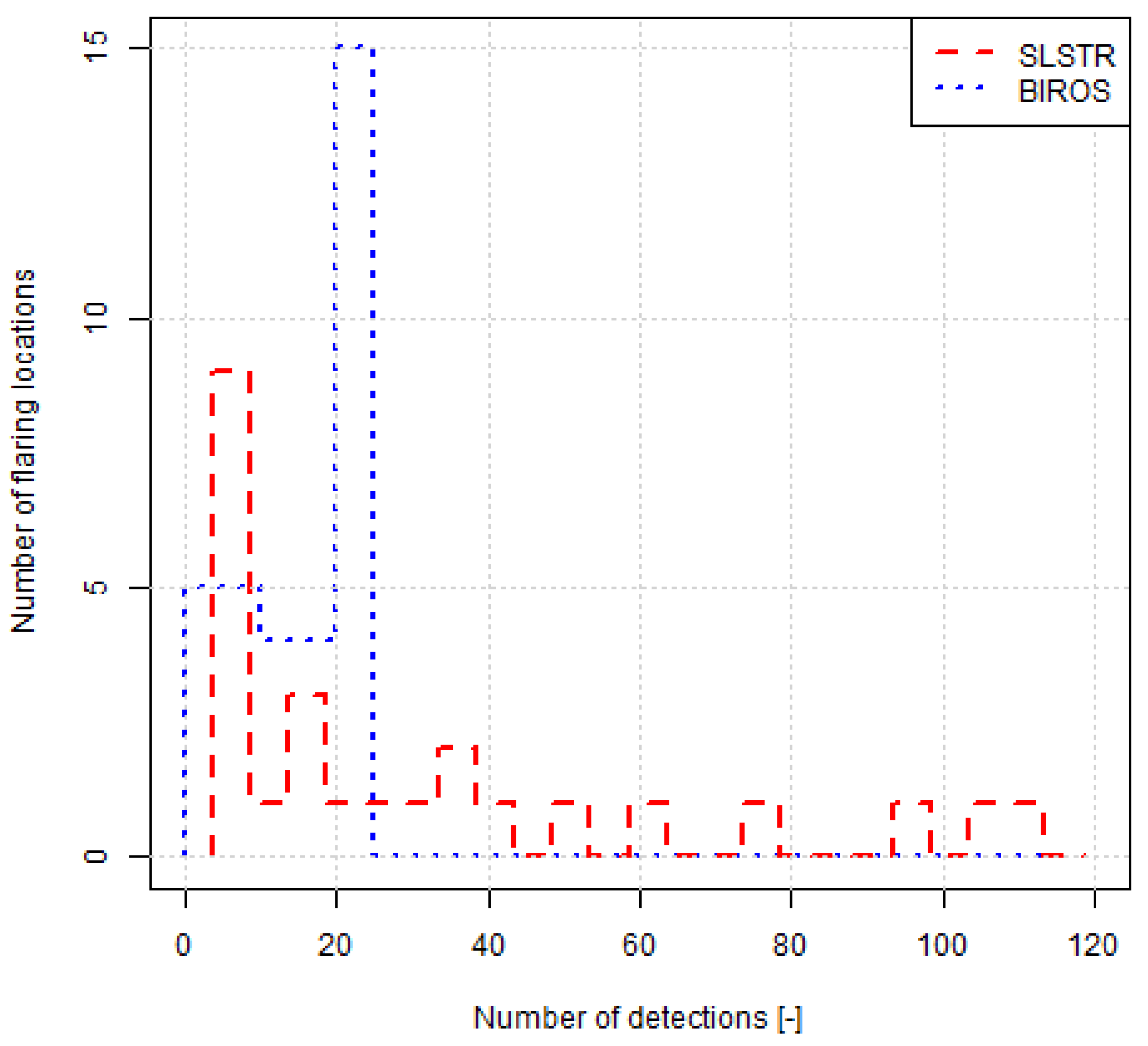


| BIROS | SLSTR | U | Within | |||||||
|---|---|---|---|---|---|---|---|---|---|---|
| Flare ID | Mean | IQR | n | Mean | IQR | n | Test | Variability | ||
| 1 | 5176 | 6269 | 2538 | 24 | 1691 | 1067 | 643 | 39 | 1.3 | TRUE |
| 2 | 1828 | 895 | 983 | 22 | 4269 | 6690 | 1350 | 60 | 0.031 | TRUE |
| 3 | 10,035 | 7310 | 6418 | 25 | 2926 | 3976 | 954 | 13 | 1.4 | TRUE |
| 4 | 3463 | 3587 | 1699 | 22 | 4170 | 3846 | 2897 | 109 | 0.31 | TRUE |
| 5 | 8309 | 12,219 | 3531 | 22 | 2655 | 3325 | 959 | 33 | 4.2 | TRUE |
| 6 | 13,983 | 13,912 | 6032 | 22 | 3646 | 5962 | 1083 | 48 | 8.8 | TRUE |
| 7 | 16,104 | 8849 | 13,375 | 23 | 4579 | 3772 | 3315 | 93 | 2.1 | FALSE |
| 8 | 4350 | 8122 | 1401 | 14 | 5743 | 5402 | 6712 | 105 | 0.0042 | TRUE |
| 14 | 4273 | 6091 | 1532 | 23 | 1762 | 1766 | 347 | 19 | 9.7 | TRUE |
| 16 | 1166 | 449 | 622 | 15 | 2806 | 2409 | 2557 | 33 | 0.00086 | TRUE |
| 17 | 1572 | 1019 | 641 | 18 | 4408 | 6597 | 1843 | 30 | 0.014 | TRUE |
| 25 | 1103 | 275 | 496 | 21 | 2631 | 2093 | 1613 | 73 | 1.1 | TRUE |
| 28 | 1432 | 871 | 564 | 15 | 9579 | 7718 | 5993 | 13 | 4.8 | FALSE |
| 32 | 1186 | 426 | 741 | 16 | 1384 | 650 | 338 | 14 | 0.42 | TRUE |
Disclaimer/Publisher’s Note: The statements, opinions and data contained in all publications are solely those of the individual author(s) and contributor(s) and not of MDPI and/or the editor(s). MDPI and/or the editor(s) disclaim responsibility for any injury to people or property resulting from any ideas, methods, instructions or products referred to in the content. |
© 2023 by the authors. Licensee MDPI, Basel, Switzerland. This article is an open access article distributed under the terms and conditions of the Creative Commons Attribution (CC BY) license (https://creativecommons.org/licenses/by/4.0/).
Share and Cite
Caseiro, A.; Soszyńska, A. Quantification of Gas Flaring from Satellite Imagery: A Comparison of Two Methods for SLSTR and BIROS Imagery. J. Imaging 2023, 9, 152. https://doi.org/10.3390/jimaging9080152
Caseiro A, Soszyńska A. Quantification of Gas Flaring from Satellite Imagery: A Comparison of Two Methods for SLSTR and BIROS Imagery. Journal of Imaging. 2023; 9(8):152. https://doi.org/10.3390/jimaging9080152
Chicago/Turabian StyleCaseiro, Alexandre, and Agnieszka Soszyńska. 2023. "Quantification of Gas Flaring from Satellite Imagery: A Comparison of Two Methods for SLSTR and BIROS Imagery" Journal of Imaging 9, no. 8: 152. https://doi.org/10.3390/jimaging9080152





